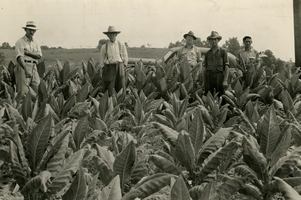
Tobacco was an important crop in West Virginia. It has been a widespread social habit and a major health problem. Although its economic importance as an agricultural crop dwindled in the late 1900s and early 2000s, West Virginians’ rates of tobacco consumption remain among the highest in the country.
West Virginia tobacco production peaked in 1909 at 14,400,000 pounds. By 1950, the annual crop was approximately 4,000,000 pounds, further declining to an average of 3,000,000 pounds during the 1990s. In 2002, 1,874,110 pounds of tobacco was produced in West Virginia on 544 farms. As recently as 1983, tobacco was the second most valuable farm crop in the state, with $8,922,000 in cash receipts. West Virginia producers saw tobacco receipts drop to $3,710,000 in 2003. In 2007, only 70 farms in nine counties produced tobacco for less than $800,000 in total receipts. By 2017, West Virginia no longer reported tobacco output and sales to “avoid disclosing data for individual operations”; however, the state ranked 17th in the nation in terms of production.
Virtually all tobacco produced in the state is the burley type, including the Yellow Orinoco and Sweet Roanoke varieties, maturing at a height of four to six feet. Historically, the main tobacco counties were Mason, Putnam, Lincoln, Cabell, and Jackson, although some tobacco was grown in more than a dozen other counties. West Virginia had mostly small, part-time producers who grew tobacco for extra income. The larger tobacco growers in the western part of the state typically grow 15 to 20 acres.
Raising tobacco is often a labor-intensive family enterprise, from the sowing of seed beds to transplanting, cultivating, harvesting, and stripping. In addition to weed elimination, plants must be inspected for tobacco worms and disease. Tobacco must be topped and suckered to promote root growth and larger leaves. During harvest in September the plants are cut and speared on poles and left in the field to wilt. Then the poles are hung upside down on tiered racks in open barns where the richly aromatic burley is air-cured for one to two months. Tobacco is readied for market by stripping and sorting the leaves and packing them into bales.
Some tobacco was made into ‘‘twists’’ and sold right off the farm well into the 20th century. Generally, however, the sale of tobacco has long been conducted through special warehouses. Shepherdstown had the first tobacco warehouse, which closed prior to the Civil War. By the late 19th century millions of pounds of burley was stored and auctioned at tobacco warehouses on the other side of West Virginia, in Cabell and Putnam counties. Warehouse operations were well established at Milton and Hurricane by the time the Huntington Tobacco Warehouse opened in 1912. It became the largest in the state and the last to remain open, closing its doors in 1998.
Opening in late November, the auction season continued until the regional crop was sold. Buyers such as Brown & Williamson, Liggett & Meyers, and others had their representatives on hand. Once the auction began, it was witty, fast-moving, and exciting with ticket markers keeping track of individual piles selling every two to three seconds. Farmers might stay in town for several days until their tobacco was sold, and the money was welcome as the holidays neared. Tobacco farmers raise their crop within a federally regulated system of acreage allotment and price supports. Allotted quotas have decreased since the late 1990s, and many West Virginia burley growers have switched to truck crops or hay.
Wheeling is home to the better-known tobacco manufacturers in the state and was once among the nation’s leading cigar producers. Marsh Wheeling Stogies made cigars in Wheeling from 1840 to 2001. Bloch Brothers began producing chewing tobacco in 1879, and the company’s Mail Pouch barn signs are regional landmarks.
West Virginia has consistently ranked among the top states nationwide in tobacco use. Statistics from the West Virginia Division of Tobacco Prevention and the national Centers for Disease Control indicate that in the 2000s, West Virginia has consistently had the highest percentage of smokers in the United States and has been second or third in the percentage of smokeless tobacco users.
In 1994, West Virginia became the third state to file suit against the tobacco industry to recover costs for smoking-related illnesses. The 1997 settlement has netted nearly $1.5 billion for the state, as of 2022. In 2007, the legislature authorized Governor Joe Manchin to sell bonds against future tobacco revenues. When the sale was completed, the state had realized $807 million dollars in revenue which was largely used to pay unfunded liabilities in state pension funds.
This Article was written by Scot E. Long
Last Revised on August 25, 2023
Related Articles
Sources
Conley, Phil & Boyd B. Stutler. West Virginia: Yesterday and Today. Charleston: Education Foundation, 1952.
Sullivan, Ken. We Lived Good Back Then. Goldenseal, (Fall 1989).
"West Virginia's Tobacco Heritage: Nourished with Pride," Pamphlet. Tobacco Institute, ca. 1981.
Cite This Article
Long, Scot E. "Tobacco." e-WV: The West Virginia Encyclopedia. 25 August 2023. Web. 26 July 2024.


Comments?
There aren't any comments for this article yet.
Click here to read and contribute to the discussion →